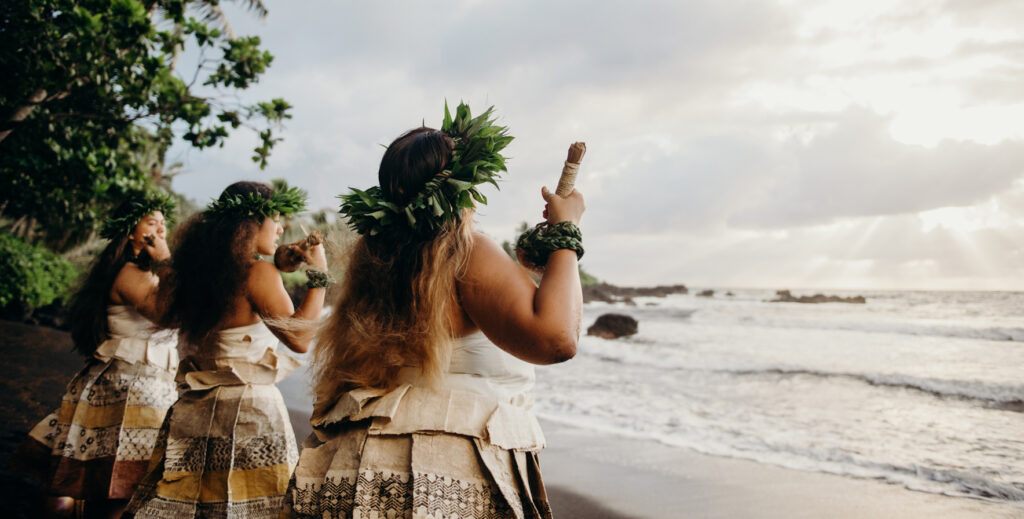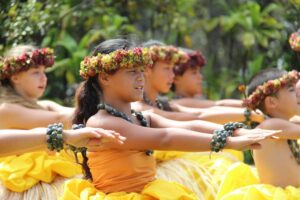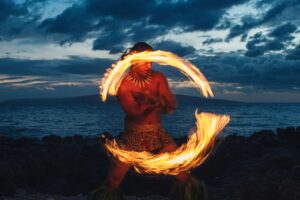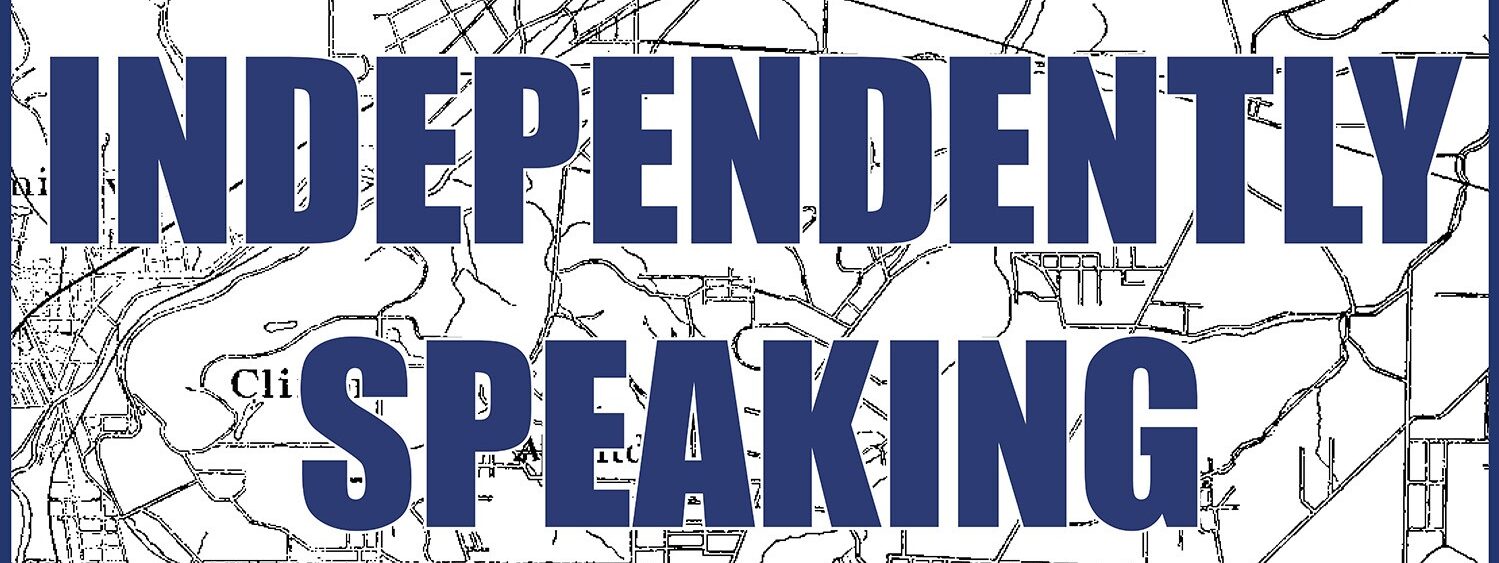Immersive Cultural Experiences: Preserving Hawaiian Traditions

Hawaii, an archipelago known for its stunning natural beauty, rich history, and vibrant culture, offers visitors a plethora of immersive experiences to delve into its unique heritage. From hula dancing to traditional luaus, the islands provide a window into the past while celebrating the present. These cultural experiences not only entertain but also educate, fostering a deeper appreciation for Hawaiian traditions.
Hula, the traditional dance of Hawaii, is deeply ingrained in the islands’ cultural fabric. It is more than just movement; it is a storytelling art form that expresses emotions, history, and spirituality. Visitors can partake in hula workshops, where skilled instructors guide them through the graceful motions and teach the significance of each gesture. By learning hula, participants gain insight into Hawaiian mythology, legends, and the connection between the land and its people.
Another quintessential Hawaiian experience is attending a traditional luau. These festive gatherings bring together locals and tourists alike to feast on delicious island cuisine, such as kalua pig, poi, and lomi lomi salmon, while enjoying live music and dance performances. Luau hosts often incorporate elements of ancient Hawaiian rituals, such as the imu ceremony, where a pig is cooked underground, paying homage to the islanders’ ancestors. Through participation in luaus, visitors not only indulge in culinary delights but also witness firsthand the resilience and spirit of the Hawaiian people.
The significance of preserving Hawaiian traditions extends beyond entertainment; it is a means of safeguarding the islands’ cultural identity and heritage for future generations. As modernization and globalization continue to influence Hawaii, there is a growing urgency to protect and promote indigenous practices. Initiatives aimed at revitalizing language, music, and crafts play a crucial role in preserving cultural integrity and fostering a sense of community among Hawaiians. By actively engaging in cultural experiences, visitors contribute to the preservation efforts and help ensure that Hawaiian traditions endure for years to come.
Celebrating Diversity: The Melting Pot of Hawaiian Culture

Hawaii’s multicultural heritage is a testament to the diverse groups that have shaped the islands’ history and traditions. From Polynesian voyagers to plantation workers from Asia and Europe, each wave of immigration has left its mark on Hawaiian culture, creating a melting pot of customs, languages, and cuisines. Embracing this diversity is key to understanding the complexities of Hawaii’s identity and fostering inclusivity within the community.
The fusion of different cultures is evident in various aspects of Hawaiian life, including cuisine. Local dishes, such as plate lunches, sushi, and loco moco, showcase the blending of flavors and cooking techniques from diverse culinary traditions. Food festivals and farmers’ markets offer opportunities to sample these delicacies while engaging with vendors who share stories of their cultural heritage. Through food, residents and visitors alike can experience the interconnectedness of Hawaiian culture and appreciate the contributions of different ethnic groups. For those seeking an adventurous culinary experience, one can also find a modern twist with extra strong cookie dough edibles, reflecting the innovative spirit and adaptability of Hawaiian cuisine. This linguistic diversity reflects the multiculturalism that defines Hawaii and serves as a bridge between past and present.
In essence, celebrating diversity is not only about acknowledging differences but also finding common ground and building connections across cultures. Hawaiian cultural experiences provide a platform for people from all walks of life to come together, share their stories, and celebrate their shared humanity. By embracing diversity, Hawaii embraces its past, present, and future as a vibrant tapestry of cultures united by aloha, the spirit of love and hospitality.
In case you’re looking to buy a new home in Hawaii, it’s essential to consider financial aspects. Finding the right mortgage company in Raleigh NC can help make your dream of owning property in paradise a reality.
Sustainable Tourism: Balancing Preservation and Progress
As Hawaii’s popularity as a tourist destination continues to soar, concerns about environmental conservation and cultural preservation have come to the forefront. Sustainable tourism seeks to address these challenges by promoting responsible travel practices that minimize negative impacts on the environment and communities while maximizing benefits for all stakeholders. Finding the delicate balance between preservation and progress is crucial for the long-term sustainability of Hawaii’s natural and cultural resources.
Many Hawaiian homeowners have also used the services of a company for roof cleaning in St. Augustine. These professionals help maintain the integrity of roofs, ensuring they stay free from debris and potential damage.
One of the key principles of sustainable tourism is minimizing carbon footprint and promoting eco-friendly transportation options. Visitors are encouraged to explore the islands using public transportation, bicycles, or on foot, reducing reliance on fossil fuels and alleviating traffic congestion. Additionally, initiatives such as beach cleanups and eco-tours educate tourists about the importance of preserving fragile ecosystems and supporting local conservation efforts. Many residents are also relying on the services of a company for dumpster rental in Timnath to properly dispose of waste and contribute to keeping the environment clean and healthy.
Community engagement is another cornerstone of sustainable tourism. By involving local residents in decision-making processes and tourism development initiatives, Hawaii can ensure that the benefits of tourism are equitably distributed and that cultural integrity is respected. Supporting local businesses, artisans, and cultural practitioners not only enhances the visitor experience but also contributes to the economic resilience of communities. For instance, when considering sustainable practices, opting for a company for solar panel replacement in Hillsborough can significantly reduce carbon emissions and promote environmental conservation within the community.
Ultimately, sustainable tourism is about fostering a harmonious relationship between visitors, locals, and the environment. By embracing practices that prioritize conservation and cultural preservation, Hawaii can continue to thrive as a premier destination while safeguarding its natural and cultural treasures for generations to come.
However, maintaining the integrity of buildings and infrastructure is also crucial. For instance, when it comes to preserving the foundations of homes or buildings, finding a reliable company for foundation repair in Plano is essential. Just as we prioritize preserving Hawaii’s natural beauty, ensuring the stability of structures ensures the safety and longevity of the community’s built environment.
Exploring Indigenous Arts and Crafts: Honoring Hawaiian Artisans
Delving deeper into Hawaiian culture, one cannot overlook the significance of indigenous arts and crafts in preserving traditions and fostering creativity. From intricate quilting to masterful wood carving, these traditional practices reflect the ingenuity and craftsmanship of Hawaiian artisans. By supporting local artists and learning about their techniques, visitors can gain a deeper appreciation for the cultural significance of these art forms.
In case you wanted to visit Hawaii but your kids suddenly got some dental problems, pediatric dentistry in Fayetteville could help ensure their smiles stay bright and healthy throughout your travels.
Quilting holds a special place in Hawaiian heritage, with roots tracing back to the 19th century when missionaries introduced the art of patchwork to the islands. Over time, Hawaiian quilters developed their unique style, characterized by vibrant colors and bold geometric patterns inspired by nature and mythology. Today, quilting remains a beloved pastime and a means of storytelling, with each quilt serving as a testament to the artist’s creativity and cultural heritage. Visitors can attend quilting workshops or visit local galleries to admire these beautiful works of art and learn about the stories they convey.
Wood carving is a big deal in Hawaii, you know? It’s like this ancient art where talented folks take wood from around here and turn it into all sorts of cool stuff. They make things like weapons from back in the day, like the leiomano, which was this club made from shark teeth! But they also carve more modern stuff, like sculptures of gods and mythical creatures. It’s pretty awesome to see these master carvers in action, making tikis and other traditional tools. And what’s even cooler is that when tourists buy these handmade souvenirs, they’re helping keep this tradition alive. It’s like supporting a local craft, you know?
Speaking of supporting local crafts, have you heard about the media production company in New Jersey? They’re all about creating awesome videos, music, and other media right here in the Garden State. It’s like they’re carving out their own niche in the industry, just like those Hawaiian woodworkers!
Environmental Stewardship: Protecting Hawaii’s Natural Wonders
While Hawaii’s cultural heritage is undeniably rich, its natural beauty is equally deserving of preservation and appreciation. The islands boast diverse ecosystems, from lush rainforests to pristine beaches, teeming with unique flora and fauna found nowhere else on Earth. However, rapid development and climate change pose significant threats to Hawaii’s fragile ecosystems, necessitating concerted efforts to protect and conserve its natural wonders.
Similarly, in Austin, locals are embracing alternative healing practices like Kambo healing in Austin, which not only nurture individual well-being but also contribute to the broader appreciation and preservation of natural health remedies.
One of the most pressing environmental issues facing Hawaii is plastic pollution. As an island state, Hawaii is particularly vulnerable to the impacts of plastic waste, which threatens marine life, pollutes beaches, and disrupts fragile ecosystems. In response, community organizations and government agencies have launched initiatives to reduce single-use plastics, promote recycling, and clean up littered shorelines. By participating in beach cleanups and supporting plastic-free initiatives, visitors can play a crucial role in preserving Hawaii’s pristine beaches and marine habitats.
Many Hawaiian residents who have problems with pests seek the services of a company for pest control in Reno NV. These pests can cause damage to homes and gardens and even pose health risks to residents. By hiring professionals to handle pest control, homeowners can effectively manage infestations and protect their properties.
Climate change poses another existential threat to Hawaii’s natural environment, exacerbating issues such as sea-level rise, coral bleaching, and extreme weather events. To mitigate these impacts, Hawaii has committed to transitioning to renewable energy sources, reducing carbon emissions, and implementing sustainable land management practices. Visitors can support these efforts by choosing eco-friendly accommodations, practicing responsible outdoor recreation, and minimizing their carbon footprint during their stay. By embracing sustainable travel practices, visitors can help protect Hawaii’s natural wonders for future generations to enjoy.
Planning a wedding in Hawaii is a dream come true for many couples. The picturesque landscapes and stunning vistas provide the perfect backdrop for exchanging vows and creating lasting memories. When it comes to capturing those special moments, couples often turn to professional photographers like Rogers Wedding Photography. With their expertise in capturing the beauty of Hawaii’s natural environment, Rogers Wedding Photography ensures that every detail of your special day is preserved in stunning imagery.
Exploring Sacred Sites: Connecting with Hawaii’s Spiritual Heritage

Throughout the islands, ancient sacred sites bear witness to Hawaii’s spiritual heritage and the enduring connection between the land and its people. From heiaus (temples) to petroglyphs and sacred mountains, these sites hold profound significance for Native Hawaiians and offer visitors a glimpse into the islands’ spiritual traditions. Exploring these sacred sites provides an opportunity for reflection, reverence, and a deeper understanding of Hawaiian spirituality.
Some Hawaiian people who moved to Dallas now have the right to use personal care services in Dallas Metroplex. These services cater to their needs, offering assistance with daily tasks and ensuring their well-being.
Heiaus, once centers of religious and cultural activity, are scattered throughout the islands, serving as tangible reminders of Hawaii’s ancient past. Visitors can visit restored heiaus, such as the Pu’uhonua o Honaunau National Historical Park on the Big Island, to learn about Hawaiian religious practices, rituals, and beliefs. Guided tours led by knowledgeable cultural practitioners provide insight into the significance of these sacred sites and their role in Hawaiian society.
Petroglyphs, rock carvings etched into lava rock surfaces, offer another window into Hawaii’s spiritual heritage. Found in various locations across the islands, petroglyphs depict symbols, figures, and stories passed down through generations. Visitors can embark on guided hikes to view petroglyph fields, such as the Puako Petroglyph Archaeological Preserve on the Big Island, and learn about the cultural significance of these ancient artworks. By respecting these sacred sites and their cultural significance, visitors can honor Hawaii’s indigenous heritage and forge a deeper connection with the land.
Some schools in Hawaii also tend to invite a school magician in Orange County to perform for their students during special events or assemblies. These magicians use their skills to entertain and amaze the young audience, bringing a sense of wonder and excitement to the school environment.
Promoting Cultural Exchange: Embracing Global Perspectives
While Hawaii’s indigenous culture is at the heart of its identity, the islands have also been shaped by waves of immigration from around the world. This multicultural heritage enriches Hawaii’s cultural landscape, fostering a spirit of inclusivity and global understanding. Through cultural exchange programs, festivals, and educational initiatives, Hawaii celebrates its diverse roots and promotes cross-cultural dialogue.
In Hawaii’s mix of cultures, people often wonder about their jobs and turn to a career advisor for help. Like the islands blend different backgrounds, a career advisor can guide you through job options in tourism, conservation, or tech. They’re there to support you in figuring out what’s next in your work life.
Cultural exchange programs provide opportunities for residents and visitors to engage with people from different backgrounds and learn about their customs, traditions, and perspectives. From homestays with local families to language exchange programs and cultural immersion experiences, these programs offer a glimpse into everyday life in Hawaii and foster meaningful connections between individuals from diverse backgrounds. By participating in cultural exchange activities, visitors gain a deeper appreciation for Hawaii’s multicultural identity and the interconnectedness of global communities.
If you are looking to equip your new home in Hawaii with modern furniture prototypes in Los Angeles, you might find unique pieces that reflect both local and international influences, adding a touch of contemporary flair to your island living space.

Festivals and events celebrating different cultures are also a hallmark of Hawaii’s cultural landscape, offering opportunities for residents and visitors to come together and celebrate diversity. From the Pan-Pacific Festival, which showcases music, dance, and cuisine from across the Pacific Rim, to the Honolulu Festival, which highlights the cultural heritage of Hawaii’s Asian and Pacific Islander communities, these events foster a sense of unity and appreciation for Hawaii’s multicultural heritage. By attending cultural festivals and supporting local artists and performers, visitors can contribute to the vibrancy of Hawaii’s cultural scene and promote cross-cultural understanding.
If you’re into fitness, you might find it interesting to know that there’s a workout approach called the Mike Mentzer HIT program. Just like how these festivals bring together various cultures, this program brings together different fitness techniques to help you achieve your goals.
Educational initiatives aimed at promoting cultural awareness and understanding play a crucial role in fostering a more inclusive society. Schools, museums, and cultural institutions offer programs and resources that teach residents and visitors about Hawaii’s diverse cultural heritage, from its indigenous roots to its immigrant communities. By engaging with these educational initiatives, visitors can gain a deeper understanding of Hawaii’s multicultural identity and the contributions of different ethnic groups to the islands’ rich tapestry of culture and history. Just like how a TV riser elevates your television, these initiatives lift our knowledge and appreciation for the cultural diversity around us. Through mutual respect, empathy, and open-mindedness, Hawaii continues to embrace its role as a cultural crossroads and bridge between East and West, past and present.
Conclusion
The preservation of Hawaiian traditions and cultural heritage is a multifaceted endeavor that encompasses art, cuisine, language, environmental stewardship, spirituality, and cross-cultural exchange. By actively engaging with these aspects of Hawaiian culture, visitors can gain a deeper appreciation for the islands’ rich heritage and contribute to ongoing preservation efforts. As Hawaii continues to evolve as a cultural crossroads and beacon of aloha, it remains committed to safeguarding its natural and cultural treasures for future generations to cherish and enjoy. Through education, respect, and collaboration, Hawaii celebrates its past while embracing the opportunities of the future, ensuring that its cultural legacy endures for generations to come.
